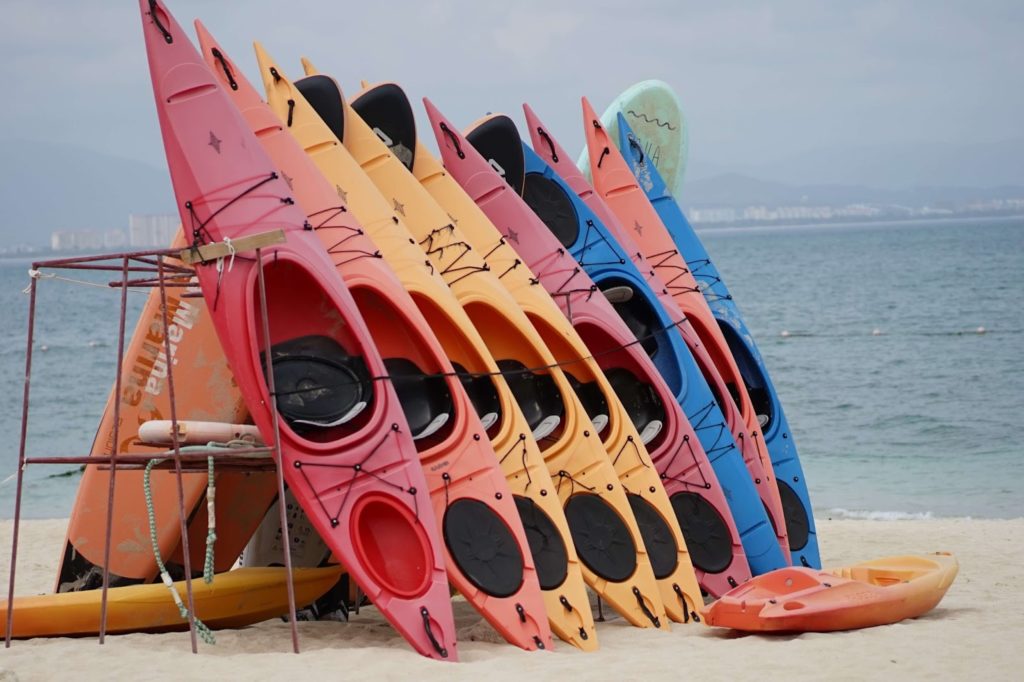A Guide to Fitting and Transporting Kayaks on a Roof Rack
Traveling with kayaks can be pretty inconvenient. They are large, have an odd shape, and can be incredibly heavy. But will that stop us from taking our kayaks out on kayaking trips? Absolutely not! So to help you go on your journey, let’s look into how many kayaks on a roof rack can fit securely and the best way to travel with kayaks.
Traveling for Your Kayaking Trip

Before your kayaking trip, you’ll need to pack all of the essentials and adequately secure your kayak in advance. This section covers what equipment you need and how to pack and travel with your kayak efficiently.
Kayaking Essentials

Regarding the kayaking essentials, you must bring your kayak and paddle. Remember that kayaks can come in all shapes and sizes, potentially making them more challenging to pile on a car. Paddles can also come in several sizes, though depending on the length, you can likely store your paddle inside the vehicle.
If you have an inflatable kayak, you can simply place it on the trunk and inflate it after traveling. There are even some inflatable kayaks that can compress enough to wear as a backpack. Make sure to bring a pump to re-inflate it after getting to your destination.
Other items you must bring on your trip include wetsuits, sunscreen, kayaking life vests, and a small first aid kit. Furthermore, you should bring a waterproof bag to store all of your items when in the water. However, these items are relatively small and should pose no problem packing.

Maximum Number of Kayaks on a Roof Rack
For safety purposes, many recommend that you secure no more than two kayaks on the roof of a car. If you have a van or a larger car, you might be able to fit four kayaks without stacking. With kayak stackers and smaller, more lightweight kayaks, you may be able to fit four on a smaller car.
Several kayak brands also do not recommend stacking your kayaks. Stacking can lead to scratches and damage to the surface of your kayak.
Securing Your Kayak
When traveling with heavy kayaks, you must first use the proper type of equipment. Try to get these items in advance to learn how to use them and how they work.
Equipment
You will need to have three things on hand the day you pack. If you don’t have these items, it will be very challenging to secure your kayak correctly, and it can cause some safety concerns since you are traveling in a fast-moving car.
Roof Rack

Roof racks are essential for securing a kayak to your car. Without a roof rack, you won’t be able to use roof rack bars, and you may see scratches on your vehicle and your kayak. It is important to note that they can be costly to install unless you already have roof racks.
Roof Rack Bars (J bars)
A J bar is one that you attach to the roof rack so that it can hold your kayak. A J bar is a metal gadget that has a similar shape to the letter J. It also has mounting brackets to mount to the roof rack and straps to secure the kayak.
High-quality J bars have a good layer of padding on parts of the bar to protect the car and your kayak. You should have 2 bars for one kayak to secure both ends. Two kayaks need 4 J bars, three kayaks need 6, and so on.
Straps
Straps typically come as part of a roof rack bar set. However, you can also purchase different straps as long as they can hold the bar to the kayak. Straps should be durable, lengthy, and not flexible.
Instructions
Securing your kayak is not too challenging, though it can be much easier if you have an extra pair of hands. In this section, let’s look at how to stack your kayak on the roof of your car correctly.
The most challenging aspect of securing your kayak is the lifting process. Since kayaks can be heavy, try to lift with the help of two or more people. However, since it can be more difficult for one person, let’s cover how to load a kayak with a single person.
Step 1: Lift and Load

Firstly, you need to place your kayak on a flat surface to make it easier to hold and balance. Your kayak should have a cockpit in the middle where you sit, so bend your knees and place one hand on the edge of one side of the cockpit and the other hand holding the bottom of the kayak.
Grasp the edge of the cockpit tightly with your hand and turn the kayak while it’s still on the ground. The cockpit should face away from your body, and slowly move the kayak up using your knees to balance and then once you can secure the kayak on top of your thighs, place your hand on the opposite edge of the cockpit.
At this stage, your other hand should still support the bottom of the kayak. Use the hand on the side of the cockpit to lift, turn, and place the kayak over your shoulder. The cockpit should be half nestled on your shoulder with your hand on the inside of the cockpit.
Step 2: Preparing your Roof Rack
Step 2 will require you to lift your kayak onto the roof rack, and we will assume that you already have a roof rack and J bars for kayaks. You can secure 2 J bars on each roof rack with the bars facing outwards.
Before you stack your kayak, you should also have two straps for each J bar to secure the sides of your kayak. You don’t need to tighten your straps, so just loosely place them around the J bars.
Step 3: Place the Kayak on the J Bars
If your car roof is too tall, use a small stepladder, so you do not need to lift the kayak over your head. Even if your roof isn’t too high, a stepladder can help minimize injuries from a sprain.
While the kayak is still on one shoulder with one of your hands on the inside of the cockpit, slowly place your other hand to grasp the other side of the cockpit. Slowly lift the kayak over your head with the cockpit facing to one side. Place the kayak on the J bars so that the cockpit faces outwards (i.e., the same way as the car window).
Step 4: Secure the Kayak With the Straps

The last step involves using the straps you loosely added earlier. When transporting your kayak, you should have a strap with a buckle on one end to secure one end to the other.
Place the strap for one J bar around the kayak, ensuring you can see the buckle. The other side of the strap should first wrap around the back of the kayak and then the crossbar (the equipment holding the J strap to the roof rack).
Tighten the strap and then secure it to the buckle. After tying to the buckle, you should again tighten the strap. Repeat the process for the other strap to secure the stern and the bow of your kayak tightly.
Arriving at Your Kayaking Destination
After you’ve finally pulled up to your destination, you need to take your kayak from your car and transport it to a secure storage container. Unbuckle the straps and remove the kayak by placing one hand inside the cockpit and securing the bottom using your other hand.
Lift the kayak and place it on one shoulder. Either place it down by slowly bending your knees then your back, or carry it until you reach a storage area.
Conclusion
It is relatively easy to travel with kayaks once you know what you’re doing. After securing one kayak, you can even fit three of four, depending on the size of your vehicle. If you’re going on a kayaking trip anytime soon, consider using the instructions above to safely secure your kayak on the roof of your car or van.
Frequently Asked Questions
Can You Put Kayaks on Top of Each Other?
You can stack kayaks on top of each other on a roof rack, given that you have a stacker, and use secure straps. However, there is a limit to how many you can stack on top of one another before it becomes unstable, so we recommend you stack at most two.
How Do Kayak Stackers Work?
Kayak stackers are very useful when stacking two kayaks on top of one another. The quality and longevity of stackers can vary depending on the brand and the material. Nonetheless, if you choose a quality stacker, it should work.
Should You Tie Down Front and Back of a Kayak?
Yes, you should use a bow and stern strap to secure the back and front of your kayak. Failing to do so can potentially cause your kayak to be unstable. Racks may also sometimes fail, so tying down kayaks is an additional precaution.
How Heavy Is a Kayak?
Kayaks can weigh between 25 lbs to over 100 lbs, though it varies depending on the type of kayak you have. Fishing kayaks are even more weighty at 120+ lbs. Inflatable kayaks can weigh around 30 lbs, and tandem kayaks weigh on average 60 lbs.
